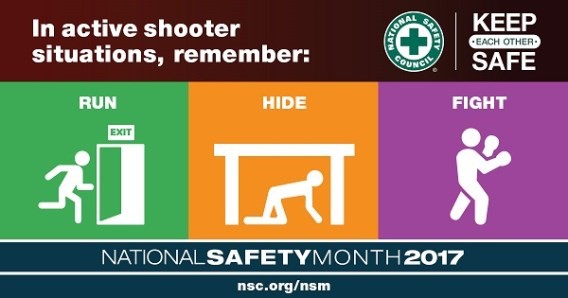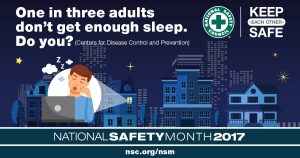June is National Safety Month
Week 3: Prepare for Active Shooters
Through the month of June, we are focusing on safety topics impacting people in both the occupational and non-occupational environments. The third topic in our series focuses on how to respond to an active shooter situation.

Did You Know?
No one wants to think about being involved in a situation with an active shooter – it can be scary, unpredictable and unfold quickly. Because active shooters often behave erratically, they have no pattern and their victims are usually random. Being prepared can be your best defense. The National Safety Council has offered several tips to respond to an active shooter situation:
- Active shooters can appear in public places such as movie theaters and shopping malls or in private workplaces. No matter where you are, remain as calm as possible.
- Be aware of any possible danger in your environment.
- Identify the two nearest exits.
- If you can flee, do so immediately – leave belongings behind.
- If you cannot flee, hide in an area where the shooter can’t see you.
- If you are behind a door, try to lock or block entry to it.
- Silence electronic devices.
- As a last resort, try to incapacitate the shooter. Keep moving and be distracting. In close range situations, fighting increases your chance of survival.
- Call 911 as soon as you can do so safely.
Wait for law enforcement to arrive Law enforcement will usually be required to end the situation. Help them by complying with them so that they can resolve the situation as quickly as possible. There are several ways you can assist:
- To the best of your ability, be prepared to provide 911 and law enforcement with your location, the number of shooters, physical description of the shooter(s), the number and type of weapons used by the shooter(s) and the number of potential victims.
- When law enforcement arrives, remain calm and follow all instructions.
- Don’t scream or yell.
- Keep your hands raised, visible and free of any objects.
- Evacuate the area quickly – do not stop law enforcement to ask questions or for help.
Facing an active shooter can be unimaginable, but being prepared might save your life. Remember to stay alert and as calm as possible. Try to run first, hide if you cannot flee safely and fight only when you have no other choice. Stay tuned! Next week we’ll be talking about Ergonomics. Thank you and Stay Safe!
Greg, Glenn, and Your Team at Madison Insurance



